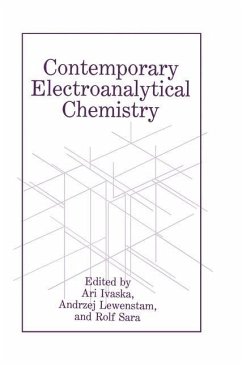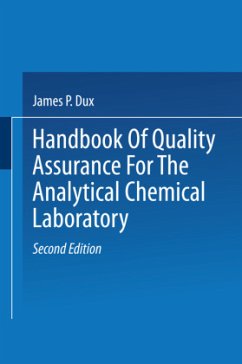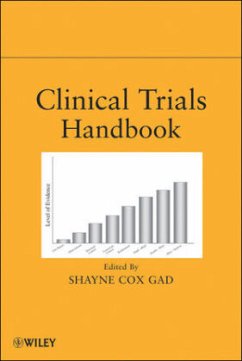
Contemporary Topics in Analytical and Clinical Chemistry

PAYBACK Punkte
20 °P sammeln!
1. Polychromatic Analysis Using the Technicon STAC(TM) Analyzer.- 1. Introduction.- 2. The STAC Analyzer.- 3. General Theory.- 4. Selection of Primary and Secondary Wavelengths.- 5. Classification of Polychromatic Analysis.- 6. STAC Assays.- 7. Examples of Polychromatic Analysis.- 8. Conclusion.- References.- 2. Introduction to Multiple-Wavelength Spectrophotometric Measurements in Analytical and Clinical Chemistry.- 1. Introduction.- 2. Definitions.- 3. Applications in Analytical Chemistry.- 4. Applications in Clinical Chemistry.- 5. Epilogue.- References.- 3. Bichromatic Analysis: The Design...
1. Polychromatic Analysis Using the Technicon STAC(TM) Analyzer.- 1. Introduction.- 2. The STAC Analyzer.- 3. General Theory.- 4. Selection of Primary and Secondary Wavelengths.- 5. Classification of Polychromatic Analysis.- 6. STAC Assays.- 7. Examples of Polychromatic Analysis.- 8. Conclusion.- References.- 2. Introduction to Multiple-Wavelength Spectrophotometric Measurements in Analytical and Clinical Chemistry.- 1. Introduction.- 2. Definitions.- 3. Applications in Analytical Chemistry.- 4. Applications in Clinical Chemistry.- 5. Epilogue.- References.- 3. Bichromatic Analysis: The Design and Function of the ABA-100.- 1. Introduction.- 2. Design Principles.- 3. Performance of Individual Instrument Functions.- 4. Automation of a Specific Method with the ABA.- 5. Quality Control.- 6. Special Applications.- 7. Epilogue.- References.- 4. Bichromatic Analysis as Performed in the Du Pont Automatic Clinical Analyzer ('aca').- 1. Introduction.- 2. Analytical Test Pack.- 3. Instrument.- 4. Measurement System.- 5. Measurement Principles.- 6. Advantages.- References.- 5. The Analysis of Matrix Formatted Multicomponent Data.- 1. Introduction.- 2. Linear Algebra Review.- 3. Theory and Application of MFMDT in Qualitative Analysis of the Fluorescence Emission-Excitation Matrix (FEEM).- 4. Theory and Application of MFMDT in Quantitative Analysis of the FEEM.- 5. Summary and Conclusion.- 6. Appendices.- References.- 6. Nonlinear Parameter Estimation of Convolved Excitation and Multiple Emission Response Functions.- 1. Introduction.- 2. Instrumentation and Analytical Parameters.- 3. Data Handling.- 4. Experimental.- 5. Results and Discussion.- 6. Summary.- References.- 7. ESCA Studies of Electrode Surfaces.- 1. Introduction.- 2. Electrode Transfer.- 3. Data Analysis.- 4. Carbonand Related Electrodes.- 5. Electrodes Involving Magnesium and Aluminum.- 6. Electrodes Involving Titanium.- 7. Vanadium Pentoxide Electrodes in Reserve Cells.- 8. Electrodes Involving Chromium.- 9. The Manganese Dioxide Electrode.- 10. Electrodes Involving Iron.- 11. Electrodes Involving Nickel.- 12. Electrodes Involving Copper.- 13. Electrodes Involving Zinc.- 14. The Niobium Electrode.- 15. The Molybdenum Electrode.- 16. Ruthenium Dioxide-Based Film Electrodes.- 17. Electrodes Involving Tantalum.- 18. Electrodes Involving Tungsten.- 19. Electrodes Involving Tin.- 20. The Study of Anodic Oxide Films on Gallium Arsenide and Related Compounds.- 21. Chemically Modified Electrodes.- 22. Studies of Solid Electrolytes.- 23. Ion-Selective Electrodes.- 24. Noble Metal Electrodes.- 25. Trace Metal Analysis.- 26. Studies of Paint Films.- 27. AES Studies of Electrode Surfaces.- 28. Conclusion.- References.- 8. Spatially Resolved Spectroscopy: Theory and Applications of the Abel Inversion.- 1. Introduction.- 2. Fundamentals.- 3. Computation of Area Matrices.- 4. Abel Inversion of Strictly Emitting Profiles.- 5. Self-Absorption and the Abel Inversion-Theory.- 6. Self-Absorption and the Abel Inversion-Examples.- 7. Background Correction in the Presence of Self-Absorption.- 8. Instrumental Misalignment and Spark Wander.- 9. Summary on Wander.- 10. True Measurement Noise.- 11. Spatially Unseparated Emission and Absorption.- 12. Conclusion.- 13. Appendix.- References.












